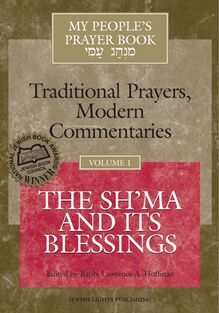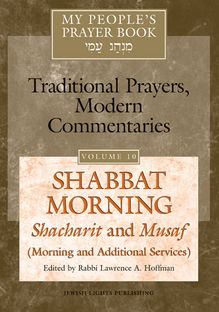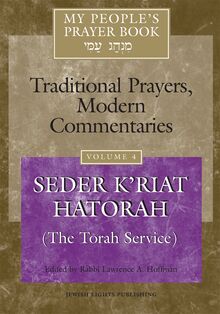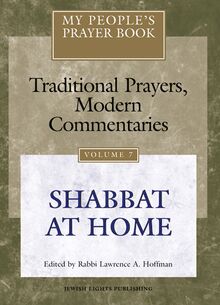-
 Univers
Univers
-
 Ebooks
Ebooks
-
 Livres audio
Livres audio
-
 Presse
Presse
-
 Podcasts
Podcasts
-
 BD
BD
-
 Documents
Documents
-
- Cours
- Révisions
- Ressources pédagogiques
- Sciences de l’éducation
- Manuels scolaires
- Langues
- Travaux de classe
- Annales de BEP
- Etudes supérieures
- Maternelle et primaire
- Fiches de lecture
- Orientation scolaire
- Méthodologie
- Corrigés de devoir
- Annales d’examens et concours
- Annales du bac
- Annales du brevet
- Rapports de stage
La lecture à portée de main
Vous pourrez modifier la taille du texte de cet ouvrage
Découvre YouScribe en t'inscrivant gratuitement
Je m'inscrisDécouvre YouScribe en t'inscrivant gratuitement
Je m'inscrisEn savoir plus
Vous pourrez modifier la taille du texte de cet ouvrage
En savoir plus

Description
"The prayer book is our Jewish diary of the centuries, a collection of prayers composed by generations of those who came before us, as they endeavored to express the meaning of their lives and their relationship to God. The prayer book is the essence of the Jewish soul." My People's Prayer Book provides diverse and exciting commentaries to the traditional liturgy, written by some of today's most respected scholars and teachers from all perspectives of the Jewish world. They explore the text from the perspectives of ancient Rabbis and modern theologians, as well as feminist, halakhic, medieval, linguistic, biblical, Chasidic, mystical, and historical perspectives. This stunning work, an empowering entryway to the spiritual revival of our times, enables all of us to claim our connection to the heritage of the traditional Jewish prayer book. It helps rejuvenate Jewish worship in today's world, and makes its power accessible to all. The My People's Prayer Book series belongs on the library shelf of every home, every synagogue—every sanctuary of prayer. Introductions tell the reader what to look for in the prayer service, as well as how to truly use the commentaries, to search for—and find—meaning in the prayer book.
MINHAG AMI: OUR DIARY OF PRAYER ACROSS THE CENTURIES Lawrence A. Hoffman INTRODUCTION TO THE LITURGY: WHAT TO LOOK FOR IN THE SERVICE INTRODUCTION TO THE COMMENTARIES: HOW TO LOOK FOR MEANING IN THE PRAYERS THE LITURGY 1. BAR'KHU Call to Prayer 2. YOTSER Blessing on Creation 3. BIRKAT HATORAH Blessing on Revelation 4. SH’MA A. "ACCEPTING THE YOKE OF THE KINGDOM OF HEAVEN" (DEUTERONOMY:4–8) B. “ACCEPTING THE YOKE OF THE COMMANDMENTS” (DEUTERONOMY:13–21) C. “THE SECTION ON TASSELS” (NUMBERS:37–41). Contents 0a Frontmatter/18/08:56 PM Page v 5. G’ULLAH Blessing on Redemption About the Commentators List of Abbreviations Glossary About Jewish Lights
Sujets
Informations
| Publié par | Turner Publishing Company |
| Date de parution | 17 mai 2012 |
| Nombre de lectures | 0 |
| EAN13 | 9781580236119 |
| Langue | English |
Informations légales : prix de location à la page 0,0550€. Cette information est donnée uniquement à titre indicatif conformément à la législation en vigueur.
Extrait
R ead may be the wrong word. Engage would be better, because this is not so much a book as it is a classic text, and Jewish classics are not read so much as they are engaged. Included here is a classic text of Jewish prayer, spanning 2,000 years of Jewish experience with the world and with God; and nine thoughtful commentaries on that text, each one reaching back in a different way, again through 2,000 years of time. The question ought to be, Who should engage this book in personal dialogue?
If you like to pray, or find prayer services baffling: Whether you are Orthodox, Conservative, Reconstructionist, or Reform, you will find that My People s Prayer Book tells you what you need to know to pray. The Hebrew text here is the most authentic one we have, and the variations among the Jewish movements are described and explained. They are all treated as equally authentic. The translation is honest, altogether unique, and outfitted with notes comparing it to others translations. Of special interest is a full description of the Halakhah (the how to ) of prayer and the philosophy behind it.
If you are a spiritual seeker or Jewishly curious: If you have wondered what Judaism is all about, the prayer book is the place to begin. It is the one and only book that Jews read each and every day. The commentaries explain how the prayers were born, and synopsize insights of founding Rabbis, medieval authorities, Chasidic masters, and modern theologians. The layout replicates the look of Jewish classics: a text surrounded by many marginal commentaries allowing you to skip back and forth across centuries of insight.
If you are a teacher or a student: This is a perfect book for adult studies, or for youth groups, teenagers, and camps. Any single page provides comparative insight from the length and breadth of Jewish tradition, about the texts that have mattered most in the daily life of the Jewish people.
If you are a scholar: Though written in friendly prose, this book is composed by scholars: professors of Bible, Rabbinics, Medieval Studies, Liturgy, Theology, Linguistics, Jewish Law, Mysticism, and Modern Jewish Thought. No other work summarizes current wisdom on Jewish prayer, drawn from so many disciplines.
If you are not Jewish: You need not be Jewish to understand this book. It provides access for everyone to the Jewish wisdom tradition. It chronicles the ongoing Jewish-Christian dialogue, and the roots of Christian prayer in Christianity s Jewish origins.
The My People s Prayer Book: Traditional Prayers, Modern Commentaries series Volume 1- The Sh ma and Its Blessings 168 pp, 978-1-879045-79-8 Volume 2- The Amidah 240 pp, 978-1-879045-80-4 Volume 3- P sukei D zimrah (Morning Psalms) 240 pp, 978-1-879045-81-1 Volume 4- Seder K riat Hatorah (The Torah Service) 264 pp, 978-1-879045-82-8 Volume 5- Birkhot Hashachar (Morning Blessings) 240 pp, 978-1-879045-83-5 Volume 6- Tachanun and Concluding Prayers 240 pp, 978-1-879045-84-2 Volume 7- Shabbat at Home 240 pp, 978-1-879045-85-9 Volume 8- Kabbalat Shabbat (Welcoming Shabbat in the Synagogue) 240 pp, 978-1-58023-121-3 Volume 9- Welcoming the Night: Minchah and Ma ariv (Afternoon and Evening Prayer) 272 pp, 978-1-58023-262-3 Volume 10- Shabbat Morning: Shacharit and Musaf (Morning and Additional Services) 240 pp, 978-1-58023-240-1
Prayers of Awe Volume 1- Who by Fire, Who by Water- Un taneh Tokef 272 pp, 978-1-58023-424-5 Volume 2- All These Vows- Kol Nidre 288 pp, 978-1-58023-430-6
My People s Passover Haggadah: Traditional Texts, Modern Commentaries Volume 1- 304 pp, 978-1-58023-354-5 Volume 2- 320 pp, 978-1-58023-346-0
MINHAG AMI: OUR DIARY OF PRAYER ACROSS THE CENTURIES Lawrence A. Hoffman
INTRODUCTION TO THE LITURGY: WHAT TO LOOK FOR IN THE SERVICE
INTRODUCTION TO THE COMMENTARIES: HOW TO LOOK FOR MEANING IN THE PRAYERS
The Liturgy
1. BAR KHU
Call to Prayer
MARC BRETTLER
ELLIOT N. DORFF
SUSAN L. EINBINDER
DAVID ELLENSON
JOEL M. HOFFMAN
LAWRENCE A. HOFFMAN
LAWRENCE KUSHNER and NEHEMIA POLEN
DANIEL LANDES
JUDITH PLASKOW
2. YOTSER
Blessing on Creation
MARC BRETTLER
SUSAN L. EINBINDER
DAVID ELLENSON
JOEL M. HOFFMAN
LAWRENCE A. HOFFMAN
LAWRENCE KUSHNER and NEHEMIA POLEN
DANIEL LANDES
JUDITH PLASKOW
3. BIRKAT HATORAH
Blessing on Revelation
MARC BRETTLER
ELLIOT N. DORFF
SUSAN L. EINBINDER
DAVID ELLENSON
JOEL M. HOFFMAN
LAWRENCE A. HOFFMAN
LAWRENCE KUSHNER and NEHEMIA POLEN
DANIEL LANDES
JUDITH PLASKOW
4. SH MA
A. Accepting the Yoke of the Kingdom of Heaven (Deuteronomy 6:4-8)
B. Accepting the Yoke of the Commandments (Deuteronomy 11:13-21)
C. The Section on Tassels (Numbers 15:37-41)
MARC BRETTLER
ELLIOT N. DORFF
SUSAN L. EINBINDER
DAVID ELLENSON
JOEL M. HOFFMAN
LAWRENCE A. HOFFMAN
LAWRENCE KUSHNER and NEHEMIA POLEN
DANIEL LANDES
JUDITH PLASKOW
5. G ULLAH
Blessing on Redemption
MARC BRETTLER
ELLIOT N. DORFF
SUSAN L. EINBINDER
DAVID ELLENSON
JOEL M. HOFFMAN
LAWRENCE A. HOFFMAN
LAWRENCE KUSHNER and NEHEMIA POLEN
DANIEL LANDES
JUDITH PLASKOW
About the Commentators
List of Abbreviations
Glossary
Copyright
About Jewish Lights
Commentators MARC BRETTLER Our Biblical Heritage ELLIOT N. DORFF Theological Reflections SUSAN L. EINBINDER Medieval Wisdom DAVID ELLENSON How the Modern Prayer Book Evolved JOEL M. HOFFMAN What the Prayers Really Say LAWRENCE A. HOFFMAN Origins of the Liturgy LAWRENCE KUSHNER AND NEHEMIA POLEN Chasidic and Mystical Perspectives DANIEL LANDES The Halakhah of Prayer JUDITH PLASKOW Feminist Theology
PRAYER AS JEWISH ART: THE EXPRESSION OF THE JEWISH SOUL
Of all the books that line the shelves of a Jewish library, it is the Siddur, not the Talmud and not even the Bible, that Jews know best. The prayer book is our Jewish diary of the centuries, a collection of prayers composed by generations of those who came before us, as they endeavored to express the meaning of their lives. To know the prayer book is to know our history from within. It is to be in touch with the soul of the Jewish people, as it has evolved in good times and in bad, through persecutions and Golden Ages. The Siddur is our encounter with 3,000 years of fate, condensed in a form available to the average Jew, who, today no less than yesterday, may have insufficient time and knowledge to dip deeply into Talmud, Midrash, philosophy and Kabbalah, but who can capture the essence of the Jewish spirit just by reading through the pages of our liturgy.
It can equally be called the spiritual tel of the Jewish People. A tel is an archeological term for a mound of earth that turns out to house successive layers of civilization that have been covered over by the sands of time. Archaeologists dig down deep into the dirt to retrieve secrets of the past buried in its physical detritus: clay pots, stone slabs, fragments of homes, jewelry, and even old toys. How could it be, we wonder, that whole civilizations lived and died here, one on top of the other? How could so much desert sand have accumulated, covering up centuries of life-and not just once, but over and over again, giving the lie to the vain hopes of emperors and generals that their petty conquests and peculiar distractions would prove eternal? They are all gone now, just as, perhaps, even our own civilization will be gone in a thousand years.
So too, like it or not, the material stuff of Jewish culture too is ravaged by time. What is left of our ancient synagogues, or even of the Temple? Or of King Herod s magnificent structures where he and his courtiers would go for a weekend s rest and respite? The entire city of David now lies buried below the humble huts of a simple Arab village. We look with amazement at the unearthed remnants of Hasmonean houses, once the homes of the Maccabees (no less), who thought their Jewish commonwealth would last forever. In Ashkelon, you can sit in a park and eat lunch on enormous fragments of Roman columns, toppled by time and resting around the grounds like so many giant boulders, as if no one had dedicated a lifetime to carving their magnificent marble capitals, as if no one had ever walked through portals they once guarded, as if the glory of Rome itself had never come to rest here. But it did. The material things of all cultures, including Jewish culture, come and go.
Sir Isaac Newton was right: Everything physical obeys the law of entropy; all we build turns, in the end, to chaos, a reminder of the tohu vavohu , the emptiness and void that God once saw when the world came to be.
But Newton was not altogether right. The evolutionary spiral that gave us human consciousness, and then religious quest and moral striving, is hardly a dissipation into nothingness. If anything it is the opposite: A demonstration of the long-term progress away from chaos and toward ever-more complex organisms. Perhaps for every failure of material culture, there is an irreversible step forward in our spiritual destiny. Jews, at least, who are taught by prophets to put our faith not in might and not in power, but in God s spirit, sense that this is so. And we point, for evidence, to the spiritual tel of Jewish time, to the accumulated reservoir of Jewish hopes and dreams: to our Siddur, our prayer book.
Some years ago, a small Midwestern town was home to a quiet unassuming man who used to say, By myself, I am a prayer book. He had been through Hitler s camps, sustained (he insisted) by Jewish liturgy. I was stronger than the other prisoners, he explained, so I survived, whereas they all died, or were killed,
-
 Univers
Univers
-
 Ebooks
Ebooks
-
 Livres audio
Livres audio
-
 Presse
Presse
-
 Podcasts
Podcasts
-
 BD
BD
-
 Documents
Documents
-
Jeunesse
-
Littérature
-
Ressources professionnelles
-
Santé et bien-être
-
Savoirs
-
Education
-
Loisirs et hobbies
-
Art, musique et cinéma
-
Actualité et débat de société
-
Jeunesse
-
Littérature
-
Ressources professionnelles
-
Santé et bien-être
-
Savoirs
-
Education
-
Loisirs et hobbies
-
Art, musique et cinéma
-
Actualité et débat de société
-
Actualités
-
Lifestyle
-
Presse jeunesse
-
Presse professionnelle
-
Pratique
-
Presse sportive
-
Presse internationale
-
Culture & Médias
-
Action et Aventures
-
Science-fiction et Fantasy
-
Société
-
Jeunesse
-
Littérature
-
Ressources professionnelles
-
Santé et bien-être
-
Savoirs
-
Education
-
Loisirs et hobbies
-
Art, musique et cinéma
-
Actualité et débat de société
- Cours
- Révisions
- Ressources pédagogiques
- Sciences de l’éducation
- Manuels scolaires
- Langues
- Travaux de classe
- Annales de BEP
- Etudes supérieures
- Maternelle et primaire
- Fiches de lecture
- Orientation scolaire
- Méthodologie
- Corrigés de devoir
- Annales d’examens et concours
- Annales du bac
- Annales du brevet
- Rapports de stage













